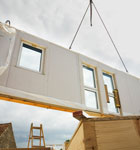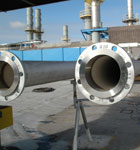At a Glance
Location
Peachtree City, GA
Founded
2003
Employees
35
Specialty
Nonferrous sustainable metal systems
Annual Sales
$15 million
Metal is a highly aesthetic choice for modern architects—flashy Daniel Libeskind buildings and Frank Gehry’s sleek Guggenheim spring to mind—but it also represents, for MetalTech-USA CEO Nils Simonsen, an uncompromising quality not reflected in other materials.
“Let’s all take a field trip in 80 or 100 years and see if our strip malls are still standing,” Simonsen says jokingly. “They won’t be. They’re disposable, right?” These shopping centers were designed with a post-World War II mentality Simonsen calls “disposable design.”
“[Before that], our design theory was much like Europe’s,” he says. “We designed smaller, and we designed higher quality.” The flat, green tint of aging copper roofs in America’s older cities—the skylines of Boston, New York, and Chicago, for example—are reminders of that time. But the post-World War II boom years saw homes go up seemingly overnight. Schools were needed in short order, and shopping centers appeared in the resulting suburban tracts. The trend of building quickly and economically continued until this latest economic slump caused a few architects to rethink it.
“I think we’re all reverting back to the old school of building and renovating,” Simonsen says. “If there are funds available, [clients] don’t want to put up something they’re going to have to change with another product in a few years.”
Top 5 Popular MetalTech-USA Product Systems
1. Reveal wall cladding is a flexible, ventilated wall-cladding system. The panels can be installed with horizontal, vertical, or diagonal orientations.
2. Corrugated sinusoidal panels are used as interior and exterior cladding, offering a textured look available in many finishes.
3. Double-lock standing-seam roofing panels, in addition to being easy to install and more weather resistant than angle-lock systems, facilitate thermal movement.
4. Shiplap façade cladding, installed horizontally and used only on angular surfaces, also lends a unique, scalloped look to modern buildings.
5. Quickstep roofing systems adapt easily to the design grid of a building and use prefinished components for quick installation.
Enter MetalTech-USA. If the new buzz words aren’t “quick and cheap,” then they are “built to last,” and the life span of a zinc roof—the star metal of the boutique, Georgia-based metal manufacturer’s systems—far exceeds that of an asphalt tile covering that might survive 10 years, if it’s lucky. MetalTech-USA also deals in steel, aluminum, copper, and titanium for use in custom wall cladding, roofing, rainwater systems, flashing, and soffits. But zinc, a material familiar to traditional Europe but fairly new in North America, is the company’s forte.
All the metals are bundled into a line called EcoChoice, meant to signify that architects using them will gain various LEED and other sustainable building credits. For example, the zinc, from the German company RHEINZINK, is nearly half recycled at the outset and then entirely recyclable after demolition, and with a life span of 80–100 years on rooftops and more than 100 on a façade, budgeting for replacement costs is a moot point. Zinc has low toxicity and pulls greenhouses gases and other pollutants into its surface as it patinates. The patination process also means it never needs to be painted or maintained. “You just put it on a façade or a roof and let it do its thing,” Simonsen says.
And the eco-friendly benefits are just icing on the cake because zinc—in a sleek, ultramodern sense—also holds up aesthetically. Its natural patina, as opposed to the washed out green of copper’s, is a comparatively neutral grayish blue with some light tonal variances throughout.
Tourists can walk to the top of Paris’s Montmartre and peer down at the architecturally stunning city, and the gray of its more-than-150-year-old zinc rooftops gleams back as a symbol of designer Baron Haussman’s lasting contributions. Simonsen is determined to have MetalTech-USA’s systems used to make a similar, however subtle, print on history. “The company’s not driven by money, power, and fame,” he says. “[Our goal is] to put out significant systems and significant projects. Significance means a project has an everlasting effect on design. It’s not something that’s just short-term eye candy. We want long-lasting results.” ABQ



